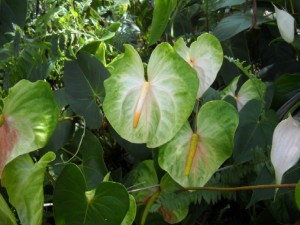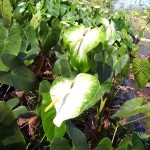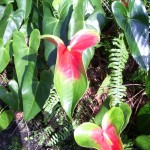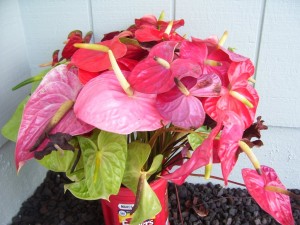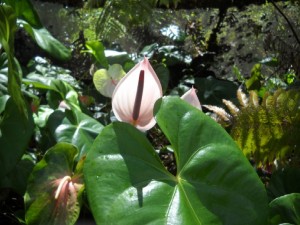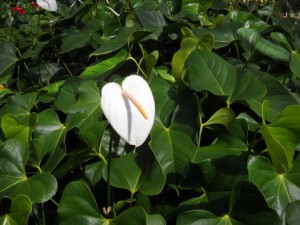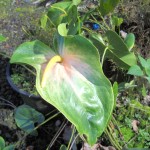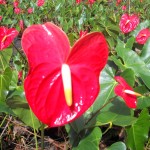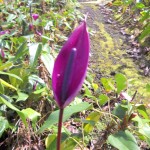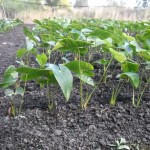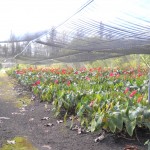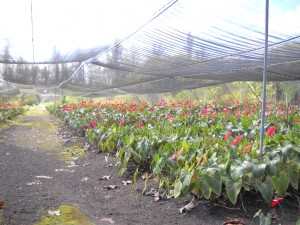Mauna Loa Anthurium
Mauna Loa Anthurium Flowers are obake anthuriums that are white and green. They tend to be white in the center and green at the edges. Mature plants can produce extra large flowers.
Ancestry of the Mauna Loa
The Mauna Loa’s mother plant was a Tropic Ice, but we don’t know who the father anthurium plant was as the Tropic Ice was open pollinated. What this means is that the pollination didn’t occur under controlled conditions, so no one knows exactly which plant produced the pollen that fertilized the Tropic Ice and fathered in the Mauna Loa.
It is a great variety for growers because it is blight tolerant and anthracnose resistant and it is also a favorite of people who like cut flowers as it can last up to 56 days in a vase when freshly cut. And even after being dry packed for three days it can still last 39 days in a vase.
How the Mauna Loa Anthurium Got Its Name
The Mauna Loa Anthurium was named after Mauna Loa, which is the second tallest of the five volcanoes that make up the Big Island. It is also the largest volcano in the world when measured by volume. Translated from Hawaiian to English, its name means “Long Mountain.” It is an active volcano that last erupted in 1984. The city of Hilo, which is the most populated city on the Big Island, is built upon its slopes, so any eruption of Mauna Loa poses great danger to the city.
Marian Seefurth Anthurium
The Marian Seefurth is one of the earliest varieties of anthurium developed by the University of Hawaii. It produces a beautiful pink flower and it was released all the way back in 1963. It produces close to seven flowers a year, but it is susceptible to blight. Fortunately, it displays some resistance to anthracnose.
On our farm, our Marian Seefurth’s tend to be a little more susceptible to fungal issues with their foliage than some of the other varieties that we grow. The standard solution to this problem is frequent applications of fungicide. But rather than load up on the fungicide we try to keep things under control by spacing these plants a little further apart for better air circulation, removing heavily infested plants and carefully adjusting moisture levels.
How did the Marian Seefurth Anthurium get its name?
It was named after Marian Seefurth, who was the wife of Nathaniel Seefurth who made a generous donation to the University of Hawaii to further anthurium research.
Anthurium Flowers and Plants
ANTHURIUMS are one of the most beautiful flowers in the world. ANTHURIUM FLOWERS are produced by ANTHURIUM PLANTS, which are members of the genus ANTHURIUM. This genus consists of over eight hundred ANTHURIUM SPECIES and hybrids like OBAKE ANTHURIUM. ANTHURIUM CARE is easy and consists of finding the right place to put them and watering them properly. HAWAII is one of the first places in the world to grow anthuriums commercially.
Vase Life: Ways To Prolong The Vase Life Of Anthurium Flowers
Anthurium flowers happen to be some of the longest lasting blooms in the globe, however there are a number of things that you’ll be able to do to make them last even longer. Additionally, you may come across quite a few elements that can dramatically decrease how long they last. In this write-up, I am about to discuss what you’ll be able to do to get them to last longer and everything you must beware of in the event you wish to avoid unintentionally reducing their life.
Many scientists think that the key factor that restricts the vase life of these types of blossoms is the ability to take in water. As these blossoms lose the ability to absorb water they start to wither and expire. Exactly what happens is that the water transporting tissue of the flower gets clogged up and as soon as the flower is deprived of water it shrivels and perishes.
The initial thing that you should do when you receive brand new flowers is cut about half an inch off the bottom of their stems. This will clear any obstructions that have developed while they were being shipped. Then place them inside a clean flower vase with pure water. Any pollutants within the water may plug up the water carrying cells inside your blossoms.
The next thing that you can do would be to add a commercial bloom preservative to the water in your vase. This will prevent microbial growth, which may also plug up the pores of your blossoms.
Pay attention to the heat range of the room where you keep your flowers. Exposure to temperatures that are below 50 degrees or over 90 degrees will reduce their vase life considerably. Ideally you ought to keep them at a temperature range of 65 degrees to 75 degrees.
Ethylene gas is infamously harmful for flowers and it could significantly decrease the vase life of your blooms. So you should try really hard to keep your blooms away from it. Sources of ethylene consist of: injured plants, ripening fruit and car exhaust. Try your best to maintain your blossoms far away from these things.
To conclude, that is all there is to it. Stick to the straightforward guidelines that i have offered above and your anthurium flowers will last significantly longer.
Anthurium Shipping: How Anthurium Flowers Get From Hawaii To Your Home
Have you ever wondered how anthurium flowers get from a farm on Hawaii all the way to your home? Well it is a very involved process and a number of people and companies have to work together to make it happen. A lot of things have to go right in order for fresh anthuriums to arrive at your door. If any one step in the process fails or is delayed, wilted flowers are the result.
It all starts on an anthurium farm in Hawaii. The flowers are harvested by hand, usually with small knives that are frequently dipped in alcohol to sterilize their blades after each flower is cut to prevent the spread of a bacterial disease between plants. The flowers are then put in containers of water and stored at a farm building for pickup.
Next, the distributor will pick up the containers of flowers and put them into a van. While taking the flowers to the packing facility, the driver has to drive very carefully as an unexpected stop can knock the containers of flowers over.
At the packing facility, flowers are sorted and graded so that you get only the best flowers. They are then taken out of water and neatly placed in boxes that are lined with strips of paper to cushion them, while they are on their journey to your home.
After packing, they are then driven to an air freight company. They can only be delivered by plane as all other modes of transportation take too long. The transit company then puts the boxes on a plane, which usually takes them to the company’s distribution hub. From the distribution hub, they are delivered to your doorstep.
If there are any delays in any of the steps that I listed above, the result is wilted flowers. Furthermore, cold weather can place additional stress on your flowers as they are in transit and cause additional problems. As you can see, the path from the farm to your door is long and complex.
Obake Anthurium Flowers
In Japanese, the word obake means “a thing that changes” and it can also be translated as “ghost”. Obake anthurium flowers (which are sometimes miss-spelled obaki) could easily have received their name from either translation. They usually come in a mix of colors, so it is easy to see that their coloration could be “a thing that changes.” In addition, they are large flowers with a wavy surface, which gives them an otherworldly or ghostly feel. Here are some of my favorite types of obake anthuriums.
Tropic Sunrise
Tropic Sunrise is a very popular orange obake anthurium. It is a large flower with an orange center, surrounded by green edges, which was developed by the University of Hawaii. H. Kanemoto created it by crossing an Anuenue with a Soga Orange Obake back in 1981.
Mauna Loa
Mauna Loa is a stunning white obake anthurium flower. It possesses a white core with a green perimeter. Mauna Loa was created from an open pollinated Tropic Ice, which means that we don’t know which variety supplied the pollen to produce this strain. In addition, it has an outstanding 56 day vase life if placed in water immediately after harvest.
Other beautiful white obake varieties include Tropic Ice, Pearl and Rainbow Obake. The Rainbow Obake is particularly beautiful, because instead of having only two colors, it has three colors. It is white in the center, has green edges and it has pink veins. Pink obake varieties include the Anuenue Obake, Kimi Obake and Watermelo Obake.
Red Obake Varieties
There are a number of red obake varieties, most have a red core surrounded by green edges. They include the Kalapana Obake, Charade Obake, Madame Pele and the Oshiro Red Obake. The Kalapana is named after a region in Hawaii that was known for having a beautiful black sand beach that was covered by a lava flow from Kilauea Volcano, which according to Hawaiian legends is the home of volcano goddess Pele, whom the Madame Pele Obake is named after.
Buying Obake Anthuriums
When you are looking to buy flowers or obake anthurium plants be prepared to pay more. These flowers are much larger and much showier than standard varieties and they are also much rarer, so naturally they are going to cost more. So if they are more expensive, don’t be alarmed. However, you will get good value for you money as these flowers look amazing and come in some very special color combinations.
If you plan on buying obake plants, just make sure you know what you are doing when it comes to anthurium care. Obake anthuriums are harder to grow than other varieties. Their large flowers and leaves make them more vulnerable to pests, diseases and the elements.
Tips For When You Buy Anthurium Flowers
When ordering anthurium flowers, there are a few things that you should know. The difference between knowing and not knowing these things can be the difference between being happy or being unhappy with your purchase.
Firstly, the number one rule is to know exactly what you are ordering. Just about all websites will show you pictures of beautiful anthurium bouquets, whether they are selling bouquets or loose flowers. But if you unknowingly order loose flowers and are expecting a bouquet you will be sorely disappointed. The key here is to read the details on what you are ordering and to ask if the description is unclear.
If you are ordering a bouquet, you can skip over the tips that follow. But if you are ordering loose anthurium flowers, read on.
If you live in a region that gets cold during the winter, be very careful when ordering at this time. Anthurium flowers are extremely sensitive to frost and can be damaged by exposure to cold temperatures when in transit. So, if at all possible, order during a warmer time of the year. Or if you simply have to order during the wintertime, choose the fastest shipping option available and request that they be shipped in an insulated box. And be sure that you are home to receive them immediately upon delivery, as they don’t take well to sitting on a freezing door step.
To get the freshest flowers and best selection, only buy when they are plentiful. Anthurium plants are most productive during the spring and summer growing seasons. If you order during these times there is often an excess supply of flowers and this will ensure that you get the best flowers. If you order during the winter, when flowers are scarce, you may end up getting leftovers. Keep in mind that winter and summer are reversed in the northern and southern hemispheres. So Costa Rica’s summer occurs during December, while Hawaii’s summer occurs during June.
Finally, when your order arrives, unpack your flowers immediately. Clip a half an inch of the bottom of their stems and place them in water right away. Clipping their stems is absolutely vital; since, your flowers will be in a dry box during transit the pores in the bottom of their stems close up as they dry out. If you were to place them in water without trimming them, they will remain closed, and not absorb water.
Anthurium Flower Overview
Anthurium flowers come in many different shapes and sizes. I’m sure that you could find hundreds of different kinds of flower variations. But there are just three main types of anthurium flowers: obake, tulip and standard. These classifications are based on the shape and the color pattern of each flower.
Obake Anthurium Flowers
Obake means “ghost” in the Japanese language. Since many of the earliest anthurium growers in Hawaii were Japanese, I guess it makes sense that this type of anthurium flower would receive a Japanese name. But what is less clear is why they chose to name these types of flowers “ghost.” Perhaps, it is because these beautiful, large flowers have an ethereal quality. Obake also has a second meaning in Japanese. It can also mean “a thing that changes” or something that is in transition. Perhaps the change from one color to another that is present in all obake flowers meets this definition.
Click Here To See Our Anthurium Flower Catalog.
Obake anthuriums are, in my opinion, the most stunning type of anthurium flowers. They produce the largest flowers and they rarely found in a single boring color, but instead are multi-colored. Each flower will often have one color in the center and a different color at their edges. They are shaped like elongated hearts and their spathe is often a little wavy. They are the most expensive variety to purchase, so I guess others feel the same way that I do about them.
Tulip Anthurium Flowers
Tulip anthuriums are shaped like tulips. Hopefully this isn’t a big surprise. They tend to be the smallest variety, often producing flowers that are only two to six inches in size.
They come in a range of colors including red, pink, purple, lavender and white. Unlike other types of anthuriums, some varieties of tulip anthuriums produce a pleasant, sweet scent. Unfortunately, their fragrance doesn’t always seem to last when they shipped as a cut flower. So you may need to find a tulip anthurium plant that is in bloom to experience their pleasing fragrance for yourself.
Standard Anthurium Flowers
Standard anthuriums are the oldest and most common variety of anthurium. They are what most people think of when the word anthurium is mentioned. They are shaped like perfect Valentine’s Day hearts and the majority come in solid colors, thought a minority come in multi-colored patterns. They typically range in size from three to eight inches and the most famous color is red. Though they can also come in orange, green, pink, various pastels and purple. Multi-colored varieties can have an obake-like color pattern or they can also be speckled.
Pictures From Our Farm
Here are a few pictures of the anthurium flowers that live on our farm. Would you believe that some of these anthurium plants are almost as old as I am? Well it’s true, if they aren’t harmed by injury or disease, anthurium plants can outlive us. We take top cuttings, plant them, let them grow for a few years and take top cuttings again, and this cycle repeats almost endlessly.
A Common Mistake When Ordering Anthurium Flowers
When ordering anthuriums for the first time, a common mistake is to not know exactly what is being ordered. Often, people will see a picture perfect anthurium bouquet or arrangement on a website and expect that this arrangement is exactly what they are going to be getting. But when it finally arrives and they open the box they are disappointed to find a bunch of loose flowers that they have to arrange on their own. To guard against making this mistake, check with the retailer to find out if they are selling loose flowers or actual arrangements.
Trivia
- Anthurium means “tail flower” in the Greek language
- Samuel Damon brought the anthurium to Hawaii in 1889
- The rain forests of Central and South America were the ancestral home of anthurium plants
- Anthurium plants can be mildly poisonous, they can cause stomach issues if ingested
- There are more than 800 species of anthuriums
- Virtually all anthurium flowers are of the species Anthurium Andreanum, this includes: obake, tulip and standard anthuriums in nearly every color of the rainbow
- Anthurium flowers are perfect, meaning that they have both male and female parts
Little Known Facts About Anthurium Flowers
What you think of as anthurium flowers really aren’t flowers at all, they are actually spathes. A spathe is really just a specialized leaf, or in other words, a bract, which is essentially a cross between a petal and a leaf. The spathe can come in almost all of the colors of the rainbow, from red to violet and it can also come in a variety of shapes, from the standard heart shape to the tulip shape.
In the center of the spathe, is where the real anthurium flower resides. This is where the spadix, a.k.a.: nose, tail or inflorescence is located. The spadix is the actual anthurium flower; it is where the stamen (male part of the flower) and stigma (female part of the flower) are to be found. The stamen and stigma can only be seen with magnifying glasses and appear as tiny bumps on the spadix.
In summary, the anthurium flower consists of the following parts. The spathe, which everyone calls a flower, but which is actually just a glorified leaf; the spadix, which is the actual flower; and the stigma and stamen, which are the female and male parts of the flower that appear as tiny bumps.
Anthurium Plants
There are just two major categories of anthuriums that you may find in your local plant store: foliage varieties and flowering varieties. And the vast majority of what you see will there will be flowering varieties.
As far as foliage varieties go, the main types are Anthurium Crystallinum and Anthurium Faustinomirandae. A. Crystallinum will typically produce dark green, smooth leaves with highlighted white veins that are up to two feet in size. While, A. Faustinomirandae will often produce monstrous five foot leaves that are stiff as paperboard. But good luck finding these in your garden store, these will take a little effort to procure.
In terms of flowering varieties the two main varieties are Anthurium Scherzerianum and Anthurium Andreanum. A. Scherzerianum is a tough plant and it is an excellent choice for your first anthurium plant as it is easy to care for and tough to kill. But it leaves much to be desired in terms of the types of flowers that it produces, which are rather limited. It usually produces small white flowers with a curly orange spadix and it has smaller spade shaped leaves.
If you want the widest possible choice in flower shapes, sizes and colors, look to A. Andreanum. It is the species that is responsible for virtually all of the various types of anthurium flowers that are found in flower shops. In Hawaii, in the 1940’s, anthurium hobbyists learned how to selectively breed anthuriums. The fruit of their efforts was an explosion of different types of A. Andreanum flowers. They produced the three main flower shapes: standard, obake and tulips. And they also created many of the colors that we see today: red, orange, green, purple, pink, pastels, speckled and much, much more.
How To Care For Anthuriums
Anthuriums are strong plants and they are relatively easy to care for. There is really just two things that you need to do.
First, you need to water your plant regularly. It is critical that you give your anthurium enough water to keep it hydrated and do not give it so much water that it drowns. Ideally, you should water your plant every day, but you need to make sure that its soil drains well. You never want it to be left sitting it water. The water must drain away to allow oxygen to reach its roots. If oxygen does not reach its roots, anaerobic bacteria start to grow and will attack the root system of your plant.
Second, you need to fertilize your anthurium. The ideal way to do this is to use a very dilute liquid fertilizer once a week. But this is really too way too much work and the easier solution is to apply a slow release fertilizer every three to six months. This is much easier and produces close to the same results as the liquid fertilizer method.
Proper Growing Conditions For Anthuriums
You have to keep in mind that anthuriums come from tropical rain forests, so you’ll want to replicate this environment as closely as possible when you are growing an anthurium plant. To do this you’ll need high humidity, warm temperatures and filtered sunlight.
The ideal place to meet these conditions is a window in your bathroom. When you take a hot shower, this will produce a lot of humidity. So the first necessary condition is fulfilled. By keeping your plant in your home you will generally meet the second condition which is a warm, but not excessively hot temperature. Anthuriums love temperatures of 70 to 80 degrees and they will be happy if you keep your home at this temperature. Finally, putting your plant near a window will give it filtered sunlight. Anthuriums like a lot of light, but too much light can cause their leaves to burn. Just put your plant as close to the window as you can, without it burning.

